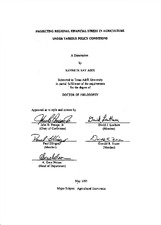| dc.creator | Adix, Kenneth Ray | |
| dc.date.accessioned | 2020-09-03T21:02:44Z | |
| dc.date.available | 2020-09-03T21:02:44Z | |
| dc.date.issued | 1995 | |
| dc.identifier.uri | https://hdl.handle.net/1969.1/DISSERTATIONS-1512885 | |
| dc.description | Vita. | en |
| dc.description.abstract | The objective of this study was to measure the relative financial stress on U.S. farmers resulting from various government policies. U.S. farmers experienced extreme levels of financial stress during the 1980s due to several factors. In the early 1970s, U.S. real net cash farm income reached historic levels and provided the impetus for the record levels of debt acquired by farmers in the latter stages of the 1970s. This debt was used to expand their operation in the hope of meeting expected future growth in demand. In the 1980s, however, the combination of low earnings, record debt, and high interest rates resulted in severe financial stress for many farmers, high loan losses for agricultural lenders, and huge government payments to farmers. A model was developed to explain regional trends in the percent of farm loan volume delinquent 30 days or more and percent of farmers filing for bankruptcy. Other indicators of regional financial stress analyzed in this study were:the times-interest-earned ratio, the debt burden ratio, the financial leverage index and the debt-to-asset ratio. An existing econometric simulation model of the U.S. economy was used to project aggregate financial statements under four different policy scenarios. The six measures of financial stress used in this study were projected from 1994 to 2000 under three policy scenarios and compared to a baseline scenario. The baseline assumes that the Conservation Reserve Program (CRP) is eliminated. The other three scenarios being compared to the baseline are: (1) a continuation of CRP, (2) a ten percent reduction in target prices from baseline levels, and (3) a two percent decrease in the growth rate of the money supply from baseline levels. Overall, the reduction in the money supply was the most financially stressful of all the policy alternatives considered in this study. The Corn Belt and Plains regions suffered the highest levels of financial stress in the U.S., especially when growth in money supply was decreased or when target prices were reduced ten percent. In general, the South region experienced the least financial stress of any region under all policy scenarios. An interesting finding was that farmers actually experienced more financial stress if CRP is continued than if it is eliminated. This mainly occurs because of the increase in deficiency payments occurring when CRP was eliminated. | en |
| dc.format.extent | xv, 143 leaves | en |
| dc.format.medium | electronic | en |
| dc.format.mimetype | application/pdf | |
| dc.language.iso | eng | |
| dc.rights | This thesis was part of a retrospective digitization project authorized by the Texas A&M University Libraries. Copyright remains vested with the author(s). It is the user's responsibility to secure permission from the copyright holder(s) for re-use of the work beyond the provision of Fair Use. | en |
| dc.rights.uri | http://rightsstatements.org/vocab/InC/1.0/ | |
| dc.subject | Major agricultural economics | en |
| dc.subject.classification | 1995 Dissertation A35 | |
| dc.title | Projecting regional financial stress in agriculture under various policy conditions | en |
| dc.type | Thesis | en |
| thesis.degree.grantor | Texas A&M University | en |
| thesis.degree.name | Doctor of Philosophy | en |
| thesis.degree.name | Ph. D | en |
| dc.type.genre | dissertations | en |
| dc.type.material | text | en |
| dc.format.digitalOrigin | reformatted digital | en |
| dc.publisher.digital | Texas A&M University. Libraries | |
| dc.identifier.oclc | 34023369 | |


